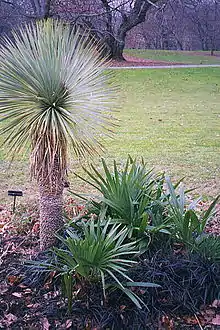Yucca thompsoniana
Yucca thompsoniana, the Thompson's yucca,[2] is a plant in the family Asparagaceae, native to Texas, Chihuahua and Coahuila.[3] Other names for the plant include Beaked yucca, Soyate and Palmita.[4]
| Yucca thompsoniana | |
|---|---|
 | |
| Scientific classification | |
| Kingdom: | Plantae |
| Clade: | Tracheophytes |
| Clade: | Angiosperms |
| Clade: | Monocots |
| Order: | Asparagales |
| Family: | Asparagaceae |
| Subfamily: | Agavoideae |
| Genus: | Yucca |
| Species: | Y. thompsoniana |
| Binomial name | |
| Yucca thompsoniana Trel. | |
| Synonyms[1] | |
| |
Yucca thompsoniana has a trunk up to 1 m tall, branching above the ground. It flowers before there is any trunk at all, but continues to flower after the stem begins to grow. Leaves are narrow and dagger-like, a bit glaucous, up to 35 cm long and 10 mm wide. Inflorescence is a panicle about 100 cm high. Flowers are white, about 4 cm long and appear in late March through early May.[4] Fruit is a dry, egg-shaped capsule.[3][5]
The plant was first collected in Chihuahua by John Bigelow in 1852 and was described by William Trelease in 1911.[4]
References
- Tropicos Yucca thompsoniana
- "Yucca thompsoniana". Natural Resources Conservation Service PLANTS Database. USDA. Retrieved 8 August 2015.
- Trelease, Report (Annual) of the Missouri Botanical Garden 22: 101 1911 publ. 1912.
- Morey, Roy (2008). Little Big Bend : Common, Uncommon, and Rare Plants of Big Bend National Park. Lubbock: Texas Tech University Press. p. 41. ISBN 9780896726130. OCLC 80359503.
- CONABIO. 2009. Catálogo taxonómico de especies de México. 1. In Capital Nat. México. CONABIO, México D.F..
This article is issued from Wikipedia. The text is licensed under Creative Commons - Attribution - Sharealike. Additional terms may apply for the media files.